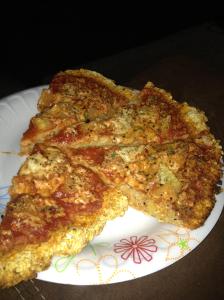
I was feeling ambitious this morning so I decided to fill you all in on ways to eat healthier, shop smarter and live happier.
Most of you have an idea what clean eating is. It is defined as cutting out as many processed foods as possible and eating foods in their rawest form. Think apples for applesauce, raw almonds for nut butter and whole wheat bread for white bread. Take a look at the ingredient list of foods around your home. You’d be surprised the items listed! A good rule of thumb is if it has more than 6 ingredients, don’t eat it. The more things listed, the more processed it is. Also, if there are items you can’t pronounce or wouldn’t shop for separately, don’t purchase it. Looking at the serving size is also huge. If more than 1/3 of the calories come from fat–put that crap down! Food companies are tricky in that they will make their serving sizes super small so the calories listed on the label look manageable. Most times there are at least 5-8 servings in frozen dinners like bagel bites, barbecue wings or pizza. If you have half of them or worse–all of them–you’re looking at quadrupling your calorie intake. Same goes for teas like Arizona tea and even Snapple. They are two servings, so if you’re enjoying the entire bottle, double those calories.
The first step to eating healthy is purging your fridge and pantry of processed foods. Stay away from canned items like soups, vegetables and fruit, boxed flavored rice and ‘just add water’ meals as well as processed meats like bologna, salami and other deli meats. Getting those items out of the house will rid you of temptation and force you to eat the foods your body truly needs.
According to studies, most Americans are starving nutritionally. We eat and eat, but it’s the wrong kind of food. Your body is your buddy, listen to it! Treat it right and it will treat you right. Tired of feeling sluggish, bloated, constipated? What if I told you that was all because of your diet? Just making a few simple changes in the foods you eat will not only give you more energy, it will improve awareness, eye sight, reduce bloat and clear up skin! No pill, cream or magic shake will do that for you. It’s all about food–the right kinds of food.
Did you know that 60% of the food we eat is processed? It’s cheaper and easier for big companies to sell mass quantities of crap than good food that spoils. Most of those foods are pumped with artificial fillers, sweeteners and other carcinogenic ingredients that would make you cringe. Then they see people trying to eat healthy so they slap “fat free” on the label and people eat twice as much than they would have before. Little do people know what they are really eating. Why do you crave certain foods? Why are they so addicting? I’ll tell you why: MSG and sugar. Would you be surprised to know there are more than 70 ingredients in a McDonald’s hamburger? MSG is one of the main ingredients which has been linked to diabetes, cancer and morbid obesity. I consider sugar a drug. It is addicting and when people don’t get it, they get irritable. People also consume more than two times the amount of sugar required a day. Eating clean can be a challenge cutting these deadly ingredients out your daily diet.
Going to the store soon? Here are some tips:
1. Shop on the edges of the grocery store. The outside edges are most times filled with fresh fruit, veggies, meats, yogurts and cheeses. Things that spoil=good. Things that have a shelf life of 5 years=bad.
2. When shopping for items, check the ingredient list! If you are buying beans, beans should be the only thing listed on the label. If you must be canned items or packaged items, go for the reduced sodium or reduced sugar.
3. Watch out for fat free! Fat free usually means ‘more sugar’ but not always. Full fat yogurts are actually better for you than fat free versions because it’s lower in sugar.
4. Go to the store with a list and stick to it! Also, try to go alone. Kids and boyfriends/husbands won’t help the cause! It will save you money and time!
5. Sign up for coupons either by mail or online. There often aren’t many deals for healthy food (surprise), but sometimes you’ll get a deal on fresh fruits , veggies and meats. Try to buy things that are on sale and STOCK UP on them!
6. Most time the frozen isle is full of processed foods, HOWEVER, frozen fruit and veggies are often times just as nutritious as fresh and lasts longer. Stock up on them!
7. Ingredient lists on food will show the most prevalent items first. If salt, flour, corn syrup, sugar are listed first–don’t even think about it!
8. Stay away from flavored foods like rice, nuts, popcorn, some kinds of yogurts etc. Flavored usually means added sugar and salt. You can add your own flavors to it like parsley, cilantro, fruit, honey and other spices.
9. Don’t shop when you are hungry. You’ll end up buying more food than necessary and it will most likely be crap food.
10. If you can afford organic, spinach, apples, strawberries, grapes, celery, peaches are just a few foods that you’ll want to spend a little more on as these are the foods with the most pesticides.
Here is also a list of 15 items all clean eating households should have on hand:
-Almond milk/soy milk
-frozen or fresh fruits and veggies
-Raw almonds/walnuts/pistachios
-sweet potatoes
-spinach/kale and leafy greens
-apple cider or balsamic vinegar
-black/pinto/kidney beans
-whole wheat pasta or brown rice
-old fashioned oats/rolled oats
-Stevia-egg whites-Mrs. Dash or other no MSG/salt spices-greek yogurt/kefir-seeds like chia and flax-whole wheat flour/coconut flour
But, Kailee I don’t know if I can give up my favorite fried and processed foods! Don’t tell yourself you CAN’T eat it. You can eat anything you’d like. It is your choice not to eat it. You will say ‘no’ a lot. Heck, I’ve been clean eating for 5 months and my family and friends still make cookies, cake, french fries, pizza and are surprised when I say ‘no thanks’. The way I look at it is flavor lasts a few minutes, but the fatty crap you put in your body is hard to get rid of and will only continue piling up. So, is it worth it? For some, yes, it is. Those people give in super easy by saying “a bite won’t hurt” and “I ate healthy today so I can have this 5-pound Cinnabon for desert”. Don’t reward yourself with food. We tend to do that–it’s Sally’s birthday, it’s _________ holiday weekend, let’s go on a date night, let’s go out with friends. What does that mean? Food. Usually bad food at that. Restaurants are notorious for huge portion sizes, salt and fat-laden foods and enough sugary treats to put Hershey’s out of business. No one is saying you can’t go out and enjoy the foods you did before, but be smart about it. Go for foods with names like saute, fresh, baked or steamed instead of fried, crispy, battered or creamy.
This lifestyle change isn’t easy. It takes work and it’s something that doesn’t happen over night. Once you start, it is the most rewarding experience ever. You will receive so much support and respect for starting and sticking with it. You CAN do this, just remember that.
“If you don’t go after what you want, you’ll never have it. If you don’t ask, the answer is always no. If you don’t step forward, you’re always in the same place.”









